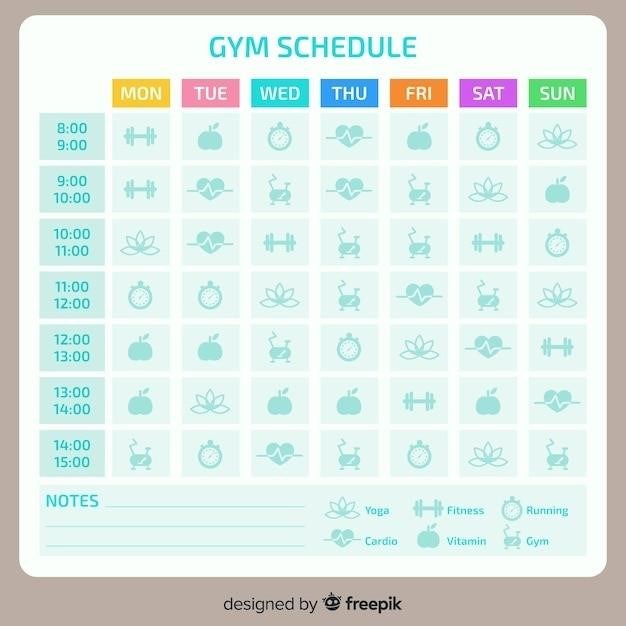Pictogramme Routine du Matin et du Soir PDF⁚ A Comprehensive Guide
This guide explores the benefits of using pictogramme routines for children, especially in the morning and evening․ We’ll cover how to create your own routines, find online resources, and even provide free printable options․ Discover how pictogrammes can promote independence and help children understand their daily schedule․

What are Pictogramme Routines?
Pictogramme routines are visual schedules that use simple pictures, or pictograms, to represent different activities in a child’s daily routine․ These routines are particularly helpful for children who are non-verbal, have difficulty understanding spoken language, or benefit from visual aids․ The pictograms can be arranged in a sequence to illustrate the order of events, making it easier for children to anticipate and understand what comes next․ For instance, a morning routine might include pictograms for waking up, getting dressed, brushing teeth, eating breakfast, and leaving for school․ Similarly, an evening routine could depict activities like taking a bath, reading a book, and going to bed․
Benefits of Using Pictogramme Routines
Pictogramme routines offer numerous benefits for children, especially those with developmental or communication challenges․ These visual aids promote independence, reduce anxiety, and improve overall communication skills․ By providing a clear visual representation of their daily schedule, pictogramme routines help children understand the flow of events and anticipate what’s coming next․ This predictability can reduce anxiety and frustration, especially for children who thrive on structure and routine․ Additionally, pictogramme routines can enhance communication skills, as they encourage children to express themselves through visual means․ They can also aid in teaching new skills, as the visual prompts can serve as reminders and support for completing tasks․ Overall, pictogramme routines empower children to participate more actively in their daily lives, fostering a sense of control and accomplishment․
Creating Your Own Pictogramme Routine
Creating your own pictogramme routine is a personalized and engaging process that allows you to tailor the visuals to your child’s specific needs and interests․ Start by identifying the key activities in your child’s morning and evening routines․ These might include waking up, getting dressed, brushing teeth, eating breakfast, and going to bed․ Once you have a list of activities, find or create simple, clear images that represent each one․ You can use online resources, clip art, or even draw your own pictures․ Consider using images that are familiar and appealing to your child․ Arrange the pictures in the order that the activities occur․ You can use a whiteboard, a bulletin board, or a simple piece of paper to create your routine chart․ Remember to keep it visually appealing and engaging for your child․ As you create your routine, be flexible and adaptable․ Adjust the pictures and activities as needed to accommodate your child’s changing needs and preferences․ With patience and creativity, you can create a personalized pictogramme routine that supports your child’s development and promotes a positive start to each day․
Finding Pictogramme Resources Online
The internet offers a wealth of resources for finding pictogrammes, making it easy to create your own routines․ Several websites provide free printable pictogramme sets, including routines for the morning, evening, and even the entire day․ These sets often feature a variety of images, covering common daily activities like getting dressed, brushing teeth, eating, and going to bed․ Look for websites specializing in autism resources, as they often offer comprehensive sets of pictograms for various needs․ For more specific or personalized options, consider using online image search engines․ Search for keywords like “pictogramme” or “visual support” along with the specific activity you need․ This allows you to find images that align with your child’s interests and preferences․ Remember to choose high-quality images that are clear, simple, and easy for your child to understand․ With a little online exploration, you can find the perfect pictograms to create a visual routine that helps your child thrive․
Free Printable Pictogramme Routines
Many websites offer free printable pictogramme routines for both the morning and evening․ These resources are a fantastic starting point, providing you with a visual structure for your child’s daily activities․ You can often find pre-made routines for various ages and needs, making it easier to find something that fits your child’s stage of development․ These printables usually feature clear and simple pictograms, making them easy for children to understand․ Some websites even offer customizable options, allowing you to personalize the routine with your child’s favorite activities or images․ Once you’ve found a printable routine, you can print it out, laminate it for durability, and even add velcro dots to create a reusable and interactive visual aid․ These free resources can be a valuable tool in introducing pictogrammes to your child and creating a sense of structure and predictability in their daily life․
Using Pictogrammes with Children
Pictogrammes can be a powerful tool for children of all ages, particularly those who struggle with verbal communication or understanding complex instructions․ They provide a visual representation of daily routines, making it easier for children to understand what comes next․ For young children, pictograms can help them learn the order of events and develop a sense of predictability, which can be particularly helpful for children with autism spectrum disorder or other developmental delays․ Older children can benefit from using pictograms to visualize their daily schedule, helping them manage their time more effectively and stay organized․ When using pictograms, it’s important to introduce them gradually and in a positive way․ Start with simple routines and gradually introduce more complex ones․ Use clear and consistent language when explaining the pictograms, and make sure the child understands the meaning of each symbol․ Pictogrammes can be used in various contexts, including at home, school, or during therapy sessions․
Pictogramme Routines for Different Ages
Pictogramme routines can be adapted to suit the developmental needs of children at different ages․ For toddlers, simple pictograms depicting basic activities like “eat,” “sleep,” and “play” can be used to establish a predictable routine․ As children grow older, the pictograms can become more complex, incorporating more specific activities like brushing teeth, getting dressed, or completing homework․ For preschoolers, visual aids like picture cards or magnetic boards can be used to create interactive routines that encourage participation․ Elementary school children can benefit from using pictograms to create visual schedules that help them manage their time and stay organized․ Teenagers may prefer using digital tools or apps with customizable pictograms to create personalized routines that fit their busy schedules․ Remember to tailor the pictogram routine to the individual child’s needs and preferences․
Integrating Pictogrammes into Daily Life
Pictogrammes can extend beyond morning and evening routines and seamlessly integrate into various aspects of daily life․ For example, they can be used to create visual schedules for mealtimes, outings, or even bedtime stories․ You can also use them to reinforce positive behaviors, such as completing chores or following rules․ Consider incorporating pictograms into your child’s play area, making it a fun and interactive learning experience․ Pictogrammes can also be helpful for transitioning between activities, such as moving from playtime to bath time․ By using them consistently, you can help your child develop a better understanding of their daily routine and anticipate upcoming events․ This can lead to increased independence, reduced anxiety, and a smoother flow of daily activities;
Tips for Success with Pictogramme Routines
Implementing pictogramme routines can be a rewarding experience, but it’s important to approach it with patience and consistency․ Start by choosing a few key routines, such as getting ready for bed or brushing teeth, and gradually introduce more as your child becomes comfortable․ Make the pictograms visually appealing and easy to understand․ Use clear, concise images that represent the actions involved in each routine․ Involve your child in the process, allowing them to choose pictograms or suggest ideas․ This helps foster a sense of ownership and encourages their participation․ Remember that routine takes time to establish․ Be patient and consistent with your approach, providing encouragement and positive reinforcement along the way․ If your child struggles with a particular step, consider breaking it down into smaller, more manageable tasks․ Most importantly, celebrate your child’s progress and acknowledge their efforts as they learn to navigate their routines with greater independence․
Pictogramme Routines⁚ A Valuable Tool for Families
Pictogramme routines offer a powerful tool for families to promote independence, reduce stress, and create a sense of predictability for children․ By visually representing daily tasks, these routines provide a clear and consistent framework for children to follow․ This can be particularly helpful for children with developmental delays, autism, or communication challenges․ Pictogramme routines can also help to reduce power struggles and decrease the need for constant reminders․ Children are empowered to take ownership of their routines and understand the expectations placed upon them․ Moreover, these routines can foster a sense of accomplishment and pride, as children learn to successfully navigate their daily tasks․ The benefits extend beyond individual children, creating a more harmonious and structured environment for the entire family․ By simplifying daily life and promoting independence, pictogramme routines can become an invaluable tool for families seeking to create a more predictable and enjoyable experience for everyone․
